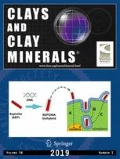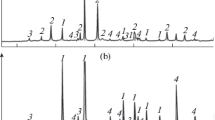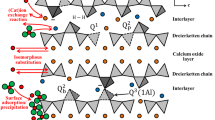Abstract
The rates of release of Al by M NH4NO3 (pH 3) from minerals saturated with Al ions at pH 3 suggest that Al ions migrated from the surface layers and the matrix cores of kaolinite, montmorillonite, illite, and biotite, but only from the matrix core of muscovite mica. From the 0.25–0.5 μm kaolinite and montmorillonite, part of the ‘surface’ Al is released ‘instantaneously’ and the rest by first order kinetics, but the coarse 1.5–2.5 /im kaolinite has only the former component. From illite and biotite, ‘surface’ Al is released by ‘bulk diffusion’ kinetics suggesting the existence of disturbed peripheral layers of finite thickness. The diffusion coefficients, Dm, for the matrix core follow the trend: mica ≃ biotite > illite > montmorillonite > kaolinite. p ]Based on models proposed in previous work, the ionic composition of the ‘surface’ Al is calculated. This shows that (1) this composition varies according to the mineral from 3 to 100% Al3+, the remainder being in the hydrolyzed form, and (2) the apparent hydrolysis constants are different for each mineral and significantly different from those of Al ions in solution.
Абстракция
Скорости высвобождения А1 с помощью M NH4NO3 (рН 3) из минералов, насыщенных ионами А1 при рН=3 позволяет предположить, что ионы А1 мигрировали из поверхностных слоев и изнутри образцов каолинита, монтмориллонита,ил-лита и биотита, но только изнутри образцов слюды мусковита. Из 0.25–0.5 дм каолинита и монтмориллонита, часть “поверхностного” Аl высвобождается “моментально” и остальной-согласно кинетике первого порядка, но грубозернистый 1,5–2,5 μм каолинит имеет только первый компонент. Из иллита и биотита,"поверхностный" Al высвобождается согласно "объемной диффузионной" кинетике, предполагающей существование наружных периферийных слоев ограниченной мощности. Диффузионные коэффициенты, Dm,для внутренних частей образцов следуют тенденции: слюда ≃биотит>иллит>монтмориллонит>каолинит.
На основе моделей, предложенных в предыдущей работе, был вычислен ионный состав “поверхностного” Al. Эти вычисления показывают Что 1/ этот состав изменяется в соответствии с минералом от 3 до 100% Аl3+, остальная часть находится в гидролизной форме и 2/ удельные гидролизные постоянные различны для каждого минерала и значительно отличаются от этих же параметров для ионов Аl в растворе.
Zusammenfassung
Die Geschwindigkeiten, mit denen Al durch 1 molare Ammoniumnitratlösung, bei pH 3 aus mit Al gesätigten Mineralien gelöst wird, deutet darauf hin, daß Al Ionen von den Oberflächen und den Gesteinsinnern von Kaolinit, Montmorillonit, Illit und Biotit,aber nur vom Innern des Muskowit-Glimmer, freigesetzt werden. Von den 0,25–0,5 ym Kaoliniten und Montmorillo-niten wird ein Teil des Oberfächen-Al unverzüglich herausgelöst und der Rest folgt Kinetik erster Ordnung; grobes, 1,5–2,5 um Kaolinit jedoch besitzt nur die erstere Komponente. Von Illit und Biotit wird Oberflächen-Al via Massendiffusionskinetik freigesetzt, was auf die Existenz einer veränderten peripheren Schicht mit begrenzter Dicke hindeutet. Die Diffusionskoeffizienten, Dm, für das Gesteinsinnere haben die folgende Tendenz: Glimmer ≃ Biotit > Illit > Montmorillonit > Kaolinit. Auf Basis von vorgeschlagenen Modellen von früherer Arbeit, wird die ionische Zusammenstellung des Oberflächen Al berechnet. Damit wird gezeigt, (1) die Zusammensetzung variiert mit dem Mineral von 3 bis 100 % Al(III), mit dem Rest in hydrolisierter Form; und (2) die scheinbaren Hydrolysenkonstanten sind unterschiedlich für jedes Mineral und sehr anders als die Konstanten für Al-Ionen in Lösung.
Résumé
Les vitesses de libération de l’Al par M NH4NO3 (pH 3) d’ions saturés d’Al à un pH de 3 suggère que les ions d’Al ont émigré des couches de surface et du noyau de la matrice de kaolinite, d’illite et de biotite, mais seulement du noyau de la matrice de mica muscovite. De 0.25–0.5 ym de kaolinite et de montmorillonite,une partie de l’Al “de surface” est libérée “instantanément” et le reste par cinétique de premier ordre; mais la kaolinite grossière de 1.5–2.5ym est entièrement libérée “instantanément”. L’Al de surface est libérée par “diffusion en masse” cinétique de l’illite et de la biotite, suggérant l’existence de couches déformées d’épaisseur finie. Les coefficients de diffusion, Dm, suivent la tendance suivante pour le noyau de la matrice: mica ≃ biotite>illite>montmorillonite>kaolinite.
En se basant sur des modèles proposés dans une étude précédente, la composition ionique de l’Al de “surface” est calculée. Ceci montre que (1) cette composition varie d’après le minéral de 3 à 100% d’Al, le restant étant dans une forme hydrolysée et (2) les constantes d’hydrolyse sont différentes pour chaque minéral et diffèrent d’une manière significative de celles d’ions d’Al en solution.
Similar content being viewed by others
References
Aveston, J. (1965) Hydrolysis of aluminium ion: Ultracentrifugation and acidity measurement: J. Chem. Soc. 4438–4443.
Bache, B. W. (1970) Barium isotope method for measuring cation-exchange capacity of soils and clays: J. Sci. Food. Agric. 21, 169–171.
Bache, B. W. (1974) Soluble aluminium and calcium-aluminium exchange in relation to the pH of dilute calcium chloride suspensions of acid soils: J. Soil Sci. 25, 320–332.
Bache, B. W. and Sharp, G. S. (1976a) Characterisation of mobile aluminium in acid soils: Geoderma 15, 91–101.
Bache, B. W. and Sharp, G. S. (1976b) Soluble polymeric hydroxy-aluminium ions in acid soils: J. Soil Sci. 27, 167–174.
Brosset, C. (1952) On the reactions of the aluminium ion with water: Acta Chem. Scand. 6, 910–940.
Brosset, C., Biedermann, G. and Sillén, L. G. (1954) Studies of the hydrolysis of metal ions. XI. The aluminium ion, Al3+: Acta Chem. Scand. 8, 1917–1926.
Brown, G. and Newman, A. C. D. (1973) The reactions of soluble aluminium with montmorillonite: J. Soil Sci. 24, 337–354.
Cabrera, F. and Talibudeen, O. (1977) Effect of soil pH and organic matter on labile aluminium in soils under permanent grass: J. Soil Sci. 28, 259–270.
Chakravarti, S. N. and Talibudeen, O. (1961) Phosphate interaction with clay minerals: Soil Sci. 92, 232–242.
Coulter, B. S. (1969) The chemistry of hydrogen and aluminium ions in soils, clay minerals and resins: Soils Pert. 32, 215–223.
Crank, J. (1956) The Mathematics of Diffusion: Oxford University Press, Oxford.
Dalai, R. C. (1975) Hydrolysis products of solution and exchangeable aluminium in acidic soils: Soil Sci. 119, 127–131.
Jackson, M. L., Tyler, S. A., Willis, A. L., Bourbeau, G. A. and Pennington, R. P. (1948) Weathering sequence of clay-size minerals in soils and sediments. I. Fundamental generalizations: J. Phys. Colloid. Chem. 52, 1237–1260.
Jackson, M. L., Hseung, Y., Corey, R. B., Evans, E. J. and Vanden Heuvel, R. C. (1952) Weathering sequence of clay-size minerals in soils and sediments. II. Chemical weathering of layer silicates: Soil Sci. Soc. Am. Proc. 16, 3–6.
Jayman, T. C. Z. and Sivasubramaniam, S. (1974) The use of ascorbic acid to eliminate interference from iron in the aluminon method for determining aluminium in plant and soil extracts: Analyst London 99, 296–301.
Lim, T. S. and Talibudeen, O. (1975) The behaviour of exchangeable aluminium in acid soils: Rothamsted Exp. Stn. Rep. Part 1, p. 87.
Lin, C. and Coleman, N. T. (1960) The measurement of exchangeable aluminium in soils and clays: Soil Sci. Soc. Am. Proc. 24, 444–447.
Low, P. F. (1955) The role of aluminum in the titration of bentonite: Soil Sci. Soc. Am. Proc. 19, 135–139.
Prakash, J. B. S. and Bhasker, T. D. (1974) Exchangeable aluminium and phosphorus sorption of some acid soils of Mysore State. Soil Sci. 118, 243–246.
Pyman, M. A. F., Posner, A. M. and Talibudeen, O. (1976) Hydrolysed aluminium ions on montomorillonite: Rothamsted Exp. Stn. Rep. Part 1, pp. 94–95.
Rawson, R. A. G. (1969) A rapid method for determining the surface area of aluminosilicates from the adsorption dynamics of ethylene glycol vapour: J. Soil Sci. 20, 325–335.
Richburg, J. S. and Adams, F. (1970) Solubility and hydrolysis of aluminium in soil solutions and saturated-paste extracts. Soil Sci. Soc. Am. Proc. 34, 728–734.
Sivasubramaniam, S. and Talibudeen, O. (1972) K-Al exchange in acid soils. I. Kinetics: J. Soil Sci. 23, 163–176.
Skeen, J. B. and Sumner, M. E. (1967) Exchangeable aluminium. Part I. The efficiency of various electrolytes for extracting aluminium from acid soils: S. Afr. J. Agric. Sci. 10, 3–10.
Smith, B. H. and Emerson, W. W. (1976) Exchangeable aluminium on kaolinite: Aust. J. Soil Res. 14, 43–53.
Stol, R.J., Van Helden, A. K. and de Bruyn, P. L. (1976) Hydrolysis-precipitation studies of aluminium (Ill) solutions. 2. A kinetic study and model: J. Colloid Interface Sci. 57, 115–131.
Talibudeen, O. and Weir, A. H. (1972) Potassium reserves in a ‘Harwell’ series soil: J. Soil Sci. 23, 456–474.
Author information
Authors and Affiliations
Rights and permissions
About this article
Cite this article
Cabrera, F., Taubudeen, O. The Release of Aluminum from Aluminosilicate Minerals. I. Kinetics. Clays Clay Miner. 26, 434–440 (1978). https://doi.org/10.1346/CCMN.1978.0260607
Received:
Published:
Issue Date:
DOI: https://doi.org/10.1346/CCMN.1978.0260607




